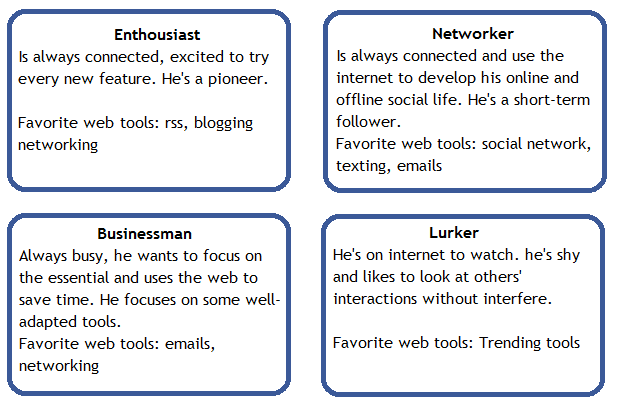Today, Facebook has a leading position in both B2C and B2B markets.
The B2C market is the one of social networks, that is, as we will see, relatively homogeneous:
Geographical Segmentation
With more than a billion monthly active users of which 80% are outside the US and Canada, Facebook is undoubtedly the world leader amongst social networks.
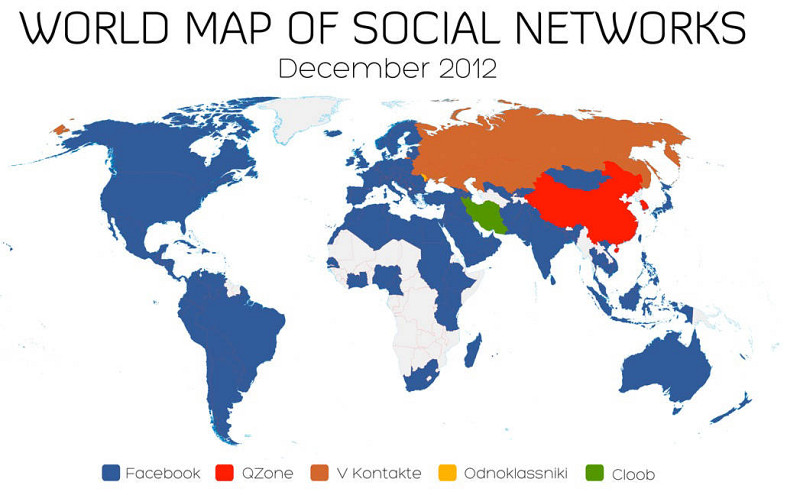
Social Networks
As we can see, Facebook is leader almost worldwide, notable exceptions being China, Iran and Russia (where Facebook still has a 47% penetration rate). It does not appear relevant to do a geographical segmentation of the social network market for the following reasons:
- There are very few legal differences between countries considering social networks
- The worldwide variations of wired connection speed does not impact Facebook browsing, as it is not very bandwith-demanding
- Needs and uses are the same worldwide: being connected and share with friends and relatives
Smartphones
Low-cost smartphone: High Growth of demand in emerging countries. It is expected that the low-cost smartphone sales will reach 29% market parts of the smartphone market.
According to a survey conducted by NPD Group, the sales of smartphone for less than 150 dollars, has doubled over the past two years.
It is expected that this trend will continue until 2016, when the sales should reach 311 million. The demand principally comes from the Pacific Asia region, Middle-East and Latin America. The demand is boosted by Pacific Asia region (60%), but the growth is also very high in Latin America, Africa, Middle-East and in Eastern Europe.
Emerging markets such as Brazil and India will face a huge growth in smartphones sales between 2013 and 2017 according to IDC (http://www.itespresso.fr/marche-smartphones-sera-tire-demande-pays-emergents-62560.html): +459% for India and +129.4% for Brzazil. China will also face an honorable growth of +52% and should thus be targeted relentlessly
Nowadays, the sales of Android smartphones for less than 200 dollars represent only 2 percent of market share. However it is expected that the low-cost smartphone sales will reach 29% market parts of the smartphone market in 2016.
Therefore, it clearly appears that there is a place to take for Facebook Phone on the low-cost smartphone market.
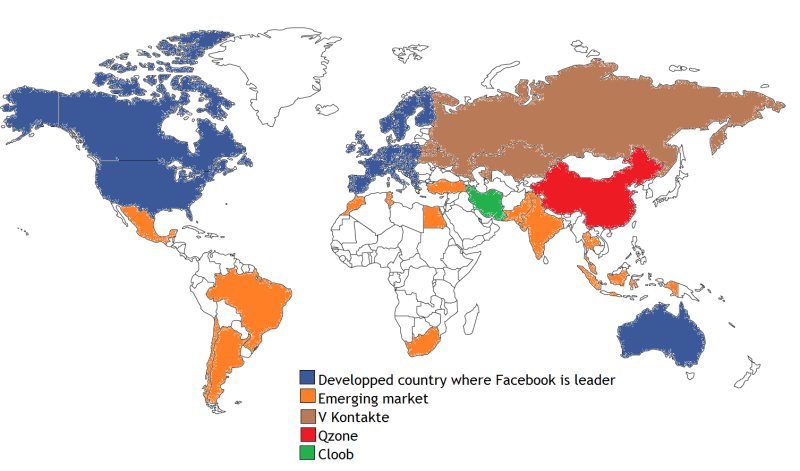
As we can see on this map, the emerging markets are a big part of the population, and by comparing it with the previous picture, we see that Facebook is leader in those countries. They thus represent a massive potential market for a Facebook device.
Socio-economic and demographic segmentation:
Devices
It does not appear suitable to divide the market with a demographic segmentation. A study realized by Mobistar on the use of smartphone by the Belgian population divide the population into age groups (-29 year, between 30 and 59 year, + 50 year). This research also studies the behavior difference between the man and the woman. It reveals a high degree of homogeneity in the use of smartphone between the man and the woman on one hand and between the -29 year and between 30 and 59 year people. Indeed, it appears that to make or receive call and to send SMS are the two principal activities on a smartphone.
If there is no significant difference between the -29 year and 30-59 year, it appears that the +50 have a different behavior. For this category of people, to make and receive calls is the only most important activity. To take picture is in second position. The other smartphone usages are less important for the seniors.
However, seniors are the less important segment. On one hand, senior population is the one which uses the least smartphones and on the other hand only a very small percentage of the senior population uses Facebook. Furthermore, the smartphone applications principally used by the seniors are not different of the ones used by the other part of the population.
Therefore, it does not appear suitable to propose different offers as a function of the demographic segmentation. The expectations and the usages of the smartphone form a homogeneous whole.
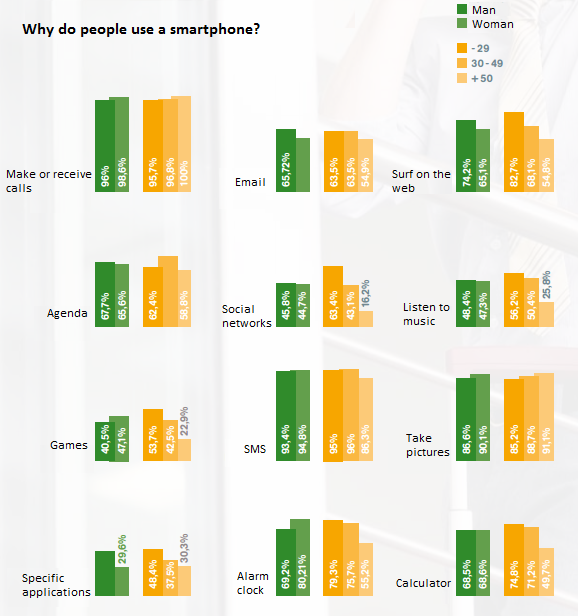
Social Networks
We have made a survey and had 230 individual answers. Here are presented the results:
The population has been segmented by age (13-17, 18-25, 26-40, 40-60, 60+). Most of the sample (73%) is between 18 and 25 years old, so this may not be entirely representative of the population, since there has been a huge growth of popularity amongst 50+ people (+13% during Q1 2012). On the other hand, the growth amongst 13-25 is not as big as it was in the past (+6%).
Thanks to the survey, we have been able to categorize the main functionalities of Facebook by age:
13-18
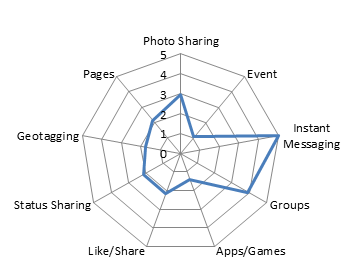 |
Main activity: Instant Messaging Importants: Groups, Photos Sharing Objectives : Contact friends, Leisures |
18-25
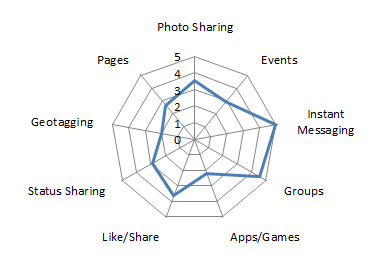 |
Main activities: Instant Messaging, Groups Importants: Photos Sharing, Like/Share, Events, Status Objectives : Contact friends, Leisures, Catch News, Education |
26-40
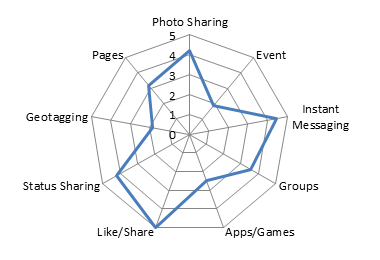 |
Main activities: Instant Messaging, Like/Share, Status, Photos Sharing Importants: Groups, Pages Objectives : Contact friends, Leisures, Catch News |
40-60
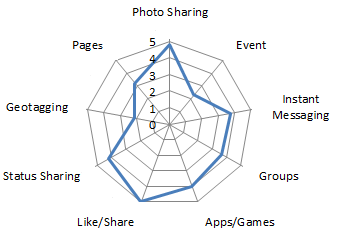 |
Main activities: Photo Sharing, Like/Share, Apps/Gales, Status Importants: Instant Messaging, Groups Objectives : Contact friends, Leisures, Catch News |
Psychographical segmentation:
We can divide the Facebook users into 4 main categories representing 4 typical profiles:
